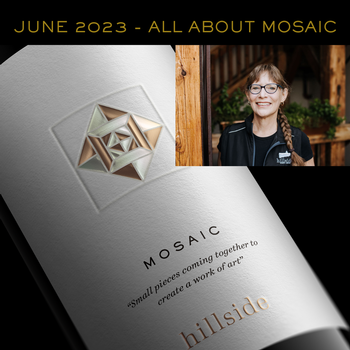Winemaker, Winemaker Blend me a Wine…
“Start with Merlot, make it taste fine, we want it to win awards when tasted blind, tell me what will Mosaic be?”
What goes into blending a wine like Mosaic?
“…for Mama add Cab Franc and Malbec, for Papa–Cabernet Sauvignon”
Vineyard skill, careful barrel selection and cellar craftsmanship come together to create a wine of great depth and finesse.
Mosaic is a classic “Bordeaux style wine, made with 5 of the 6 varieties allowed in the Bordeaux region of France: Cabernet Sauvignon, Merlot, Cabernet Franc, Petit Verdot, Malbec. (Missing is Carménère, a very late-ripening grape variety which represents only .22%of red grapes planted in BC). It is named after the Mosaic that graces the front of our wineshop, a gift to our founders, Vera and Bohumir Klokocka, in the early 90’s, and as its name suggests, it is made up of “small pieces of coming together to create a work of art.”
Similarly, Mosaic is a wine blend that brings varieties together such that the product is greater than the sum of its parts.
What is the process for making a wine of this type?
In Bordeaux it is often formulaic, as the chateaux rely on centuries of experience, with only slight changes made to adjust to growing season variations. In fact sometimes it is what is referred to as a “field blend”, with all varieties picked and processed together, as the growers and winemakers know exactly what to expect from each block of fruit.
In the Okanagan, however, we find that the fruit is evolving year by year as the vines mature and their roots dig deeper and deeper. We try to approach these varieties with a fresh outlook each year, allowing them to express what they will.
I develop an idea of what the next year’s blend will be during blending of the previous year and base some barrel purchase decisions, in late spring, on that outcome. The plan then gets massaged and refined through the growing season, tasting in the vineyard, during harvest (especially on the sorting line) and with each barrel evaluation during the 18 to 24 month period the wines are in oak.
There are some restrictions and limitations that guide the process. Petit Verdot and Malbec are available to us currently in only small quantities, so the blend starts there.They are sourced from a tiny block above the KVR trail that was planted to Muscat Ottonel in 2000. By 2004 we had recognized that this was a very warm spot, as the Muscat was ripening a full 2 weeks ahead of our mother block, so the vines were grafted over to Malbec and Petit Verdot. This allowed us, by the 2006 vintage, to shift our Mosaic blend to 100% Naramata bench fruit.
Because it is such a small planting, we need to blend these 2 varieties at time of picking to achieve a sound ferment and, hopefully, at least one full barrel for storage. This is the initial building block to provide 2%-4% Petit Verdot to the final blend.
“…for me, it’s the Petit Verdot that lends it sophistication…”
Characterized by high acidity, the Petit Verdot provides a backbone, and a nice sophistication to the final blend, with notes of saddle leather and cigar box.
As Merlot tends to be the dominant grape in the blend, with its generous black plum aromas and flavours, we use this variety for most of our barrel trials. New coopers (barrel makers), oak from various forests, and different toast levels are tested each year and the best chosen as part of the 40% to 60% new oak component of the blend.
More about oak in red winemaking here.
Cabernet Franc brings some nice herbal notes, along with black fruit to the blend. Fun fact, in 2010 and 2011 we did not have a Naramata Bench source of Cabernet Franc and, after much soul-searching, decided to leave it out of the blend until we had fruit that could make the grade. The Cinwick Vineyard, planted in 2009 just across the road in rich lacustrine soil, has been a part of the blend since 2012 and is also made into our Heritage Cabernet Franc, a wine club exclusive.
It’s possible that we have the oldest row of Cabernet Sauvignon in BC. Vera—faced with the advice that our climate could only support Germanic white varieties and some hybrid reds—decided to try a row of Cabernet Sauvignon. This row has only recently been farmed as one should a premium red, but in the meantime we planted a block of Cab Sauv just to the North of it, in 2007.This high acid variety with black fruit, and hints of herbs, mint and eucalyptus gives the blend structure, acidity and great age-ability and in warm years such as 2016 can be second to merlot in the blend.
The percentage of each variety in the blend changes from year to year as we respond to vintage variation and how that manifests in each block of fruit.
The final decisions are always by taste and the goal is always to make the best wine possible. When we have finalized the blend in the lab, we open a bottle of the previous vintage and taste it alongside the proposed blend, endeavoring to show constant improvement year over year.
“Mosaic—small pieces coming together to create a work of art.”

